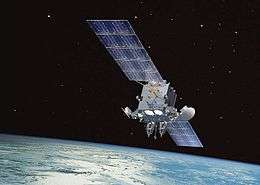USA-214
USA-214, known before launch as Advanced Extremely High Frequency 1 or AEHF SV-1, is a military communications satellite operated by the United States Air Force. It is the first of four spacecraft to be launched as part of the Advanced Extremely High Frequency program, which will replace the earlier Milstar system.[2]
 Artist's impression of an AEHF satellite | |
| Mission type | Military communications |
|---|---|
| Operator | US Air Force |
| COSPAR ID | 2010-039A |
| SATCAT no. | 36868 |
| Mission duration | 14 years |
| Spacecraft properties | |
| Bus | A2100M |
| Manufacturer | Lockheed Martin |
| Launch mass | 6,168 kilograms (13,598 lb) |
| Start of mission | |
| Launch date | 14 August 2010, 11:07:00 UTC |
| Rocket | Atlas V 531 (AV-019) |
| Launch site | Cape Canaveral, SLC-41 |
| Contractor | ULA |
| Orbital parameters | |
| Reference system | Geocentric [1] |
| Regime | Geosynchronous |
| Perigee altitude | 35,777 kilometers (22,231 mi) |
| Apogee altitude | 35,808 kilometers (22,250 mi) |
| Inclination | 2.83° |
| Period | 23.93 hours |
| Epoch | 1 November 2013 19:53:56 UTC |
The USA-214 spacecraft was constructed by Lockheed Martin, and is based on the A2100 satellite bus. The spacecraft has a mass of 6,168 kilograms (13,598 lb) and a design life of 14 years.[3] It will be used to provide super high frequency and extremely high frequency communications for the armed forces of the United States, as well as those of the United Kingdom, the Netherlands, and Canada.[2]
Launch and orbital insertion
USA-214 was launched by United Launch Alliance, using an Atlas V 531 carrier rocket flying from Space Launch Complex 41 at the Cape Canaveral Air Force Station. The launch occurred at 11:07 UTC on 14 August 2010,[4] and resulted in the spacecraft being deployed successfully into a geosynchronous transfer orbit with a perigee of 221 kilometres (137 mi), an apogee of 50,179 kilometres (31,180 mi), and 22.2° inclination.[5]
The spacecraft was intended to manoeuvre from the transfer orbit into which it was launched to its operational geosynchronous orbit by means of a Liquid Apogee Engine (LAE) and several Hall effect thrusters, a process which normally takes 105 days.[6][7][8] However, the satellite's Liquid Apogee Engine malfunctioned shortly after ignition on both its first burn on 15 August 2010 and a second attempt on 17 August,[9] and it was declared inoperable.[6][10]
To solve the problem, the perigee altitude was raised to 4700 km (2900 miles) using twelve firings of the smaller Reaction Engine Assembly thrusters, originally intended for attitude control during LAE maneuvers.[11] From this altitude, the solar arrays were deployed and the orbit was raised toward the operational orbit over the course of nine months using the 0.27 Newton Hall thrusters, a form of electric propulsion which is highly efficient, but produces very low thrust and is therefore very slow.
The problem with the Liquid Apogee Engine was later blamed on a piece of cloth accidentally left in a fuel line leading up to the engine while the line was taken apart for repair during the manufacture of the satellite. The cloth was likely placed in the line to prevent impurities from entering the fuel line and did not get removed when the line was put back together.[12]
See also
References
- Peat, Chris (1 November 2013). "AEHF 1 (USA 214) - Orbit". Heavens Above. Retrieved 25 December 2013.
- "Atlas V AEHF-1 Mission Overview" (PDF). United Launch Alliance. Archived from the original (PDF) on 22 July 2011. Retrieved 16 August 2010.
- Krebs, Gunter. "AEHF 1, 2, 3". Gunter's Space Page. Retrieved 16 August 2010.
- Ray, Justin (14 August 2010). "Rise and shine: Atlas 5 rocket successfully soars at dawn". Spaceflight Now. Retrieved 16 August 2010.
- McDowell, Jonathan (12 August 2010). "Issue 632". Jonathan's Space Report. Retrieved 16 August 2010.
- Ray, Justin (30 August 2010). "Military satellite relying on backup plan to save itself". Spaceflight Now. Retrieved 31 August 2010.
- Butler, Amy (15 November 2010). "Japanese Engine Not AEHF Issue: USAF Official". Aviation Week. Retrieved 29 January 2011.
- Butler, Amy (22 November 2010). "USAF: AEHF-1 Engine Failure An Anomaly". Aviation Week. Retrieved 29 January 2011.
- Ray, Justin (Sept. 2, 2010), Spaceflight Now, "Investigators probing what went wrong with AEHF 1" (accessed Dec. 14, 2011)
- "Main engine probably not to blame for AEHF 1 trouble". Retrieved 19 October 2010.
- Ray, Justin (October 9, 2011), Spaceflight Now, "Air Force satellite's epic ascent should finish soon" (accessed Dec. 14 2011)
- "Delicate rescue saves stranded $1.7B US satellite". Associated Press. 17 March 2012.